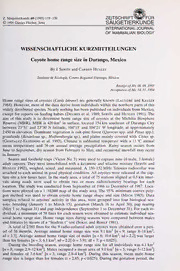Table Of ContentZEITSCHRIFT^p^FÜR
Z. Säugetierkunde60(1995)119-120
© SAUGETIERKUNDE
1995GustavFischer,Jena
INTERNATIONALJOURNAL
OF MAMMALIAN BIOLOGY
WISSENSCHAFTLICHE KURZMITTEILUNGEN
Coyote home ränge size in Durango, Mexico
ByJ. Servin and CarmenHuxley
InstitutodeEcologia, CentroRegionalDurango, Mexico.
ReceiptofMs. 08. 09. 1993
AcceptanceofMs. 14. 11. 1994
Home ränge sizes of coyotes (Canis latrans) are generally known (Laundre and Keller
1984). However, most ofthe data derive from individuals within the northern parts ofthis
widely distributed species. Nearly nothing has been published on individuals from Mexico,
except for reports on feeding habits (Delibes et al. 1989; Servin and Huxley 1991). The
aim of this study is to determine home ränge size of coyotes at the Michilia Biosphere
Reserve (MBR). MBR is 420 km2 in surface, located 154Wkm southeast of Durango City
between 23°51' and 23°30'N latitude, 104°15' and 104°21' longitude, at approximately
2450m elevation. Dominant Vegetation is oak-pine forest (Quercus spp. and Pinus spp.),
grasslands (Bouteloua sp., Mulhembergia sp.), and plains mainly covered with Cistus sp.
(Gonzalez-Elizondo et al. 1993). Climate is subhumid temperate with a 11°C annual
mean temperature and 76 cm annual average precipitation. Rainy season occurs from
June to September, dry season from February to May, and occasional snowfall may occur
in January.
Snares and foothold traps (Victor No. 3) were used to capture nine (6male, 3 female)
adult coyotes. They were immobilized with a ketamine and xilazine mixture (Servin and
Huxley 1992), weighed, sexed, and measured. A 150-152MHz Telonics radiocollar was
attached to each animal in good physical condition. All coyotes were released at the cap-
ture site a few hours later. In the study area, a total of 75 stations aligned at 0.5 km inter-
vals along roads were used to obtain two or more radiotelemetry bearings for each
location. The study was conducted from September of 1986 to December of 1987. Loca-
tions were plotted on a 1 :10,000 map of the study area. The 95% minimum convex poly-
gon method was used to obtain coyote home ränge shape and size (Mech 1983). Data
samples, related to coyotes' activity in this area, were grouped into four biological sea-
sons: breeding (January 1 to March 15), gestation (March 16 to April 30), pup rearing
(May 1 to August 31) and pup independence (September 1 to December 31). For each in-
dividual, a minimum of 58 fixes for each season were obtained to estimate individual sea-
sonal home ränge size. Home ränge sizes during seasons were compared between males
and females by means of a "Student t" test (Sokal and Rohlf 1981).
A
total of 2585 fixes for the 9 radio-collared adult coyotes were obtained over a peri-
od of 16 months. Average annual home ränge size was 9.1 km2 [n = 9; ränge 8-18km2;
sd=3.3]. Average annual home ränge size of males [n = 6; 10.6km2; sd =2.2] was larger
than for females [n= 3; 6.1 km2; sd =2.2] (t =3.91; df= 7; p <0.025).
During the breeding season, average home ränge size for all individuals was 6.1 km2
[n=8, ränge 2.9-12km2]. Males occupied a mean area of 9.0km2 [n=5, ränge 5-12 km2]
and females of 3.6 km2 [n = 3, ränge 2.9-4km2]. During this season, mean male home
ränge size is larger than for females (t = 2.85; p<0.025). During the gestation period, the
120 J. Servin andC.Huxley
average for all coyotes is 8.3 km2 [n = 6, ränge 2.9-13 km2]. Males inhabit a larger area of
9.9 km2 [n = 4, ränge 6.5-13 km2] compared to 3.2 km2 [n = 3, ränge 2.9-3.6km2] for fe-
males. However, during pup rearing season, average home ränge size is larger (12.6 km2)
than in the other three seasons. Female home ränge size is 18.4km2 which is larger than
that of males 11.5 km2 [n = 5, ränge 7-17 km2]. During pup independence season, the
average home ränge size was 11.7 km2 [n =7, ränge 5-20km2]. Males traveled within a
13.5 km2 area, whereas, females occupied a 7.3 km2 area [n = 2, ränge 5-9.7 km2].
The results indicated the average home ränge size of the coyote in Mexico is smaller
(9.1 km2) than the average of 22.8 km2 reported for Canada (Messier and Barrette
1982), and most studies in temperate [11.3 km2 to 35.8 km2 North America. In contrast,
]
the average home ränge size in the semiarid zones of Texas was 4.5 km2 (Andelt 1985).
During the breeding period, adult males patrol their home ränge and display aggressive
behavior to outside coyotes (Bekoff and Wells 1986). During the gestation season, male
coyotes were observed moving around the denning (rearing) site, transporting prey to the
lactating females and newborn pups. During pup rearing season, females are very active.
Data from direct Observation and radiotracking suggest females travel with their pups
across the home ränge. Meanwhile, males supply prey to feed the pups. During the pup
independence season, males had the largest home ränge size while the females show a
smaller home ränge size than that of the preceding season. Home ränge size changed in
shape and size throughout the year reflecting animals needs and related responses.
Acknowledgements
This research was supported byproject Michilia and CONACYT project No.P220CCOR892158. Spe-
cial thanks go to M.Vences, C.Sepülveda, and F.Huxley for their encouragement. W.F.Andelt,
T.Füller, D.Cluff, G.Aguirre, G.Adest, and two anonymous referees provided helpful comments
onthemanuscript.
References
Andelt,W.F. (1985):BehavioralecologyofcoyotesinSouthTexas.Wildl.Monogr.94, 1^15.
Bekoff,M.; Wells,M. C. (1986): Social behavior and ecology ofcoyotes. In: Study ofBehaviour. Ed.
byD.S.Lerman.NewYork:AcademicPress.Pp.251-338.
Delibes,M.; Hernandez,L.; Hiraldo,F. (1989): Comparative food habits ofthree carnivores in wes-
ternSierraMadre,Mexico.Z.Säugetierkunde54, 107-110.
Gonzalez-Elizondo,S., Gonzalez-Elizondo,M.; Cortes-Ortiz,A. (1993): Vegetaciön de la reserva
delabiosferalaMichilia,Durango.ActaBot.Mex.22, 1-104.
Mech,L.D. (1983):Handbookofanimalradio-tracking. Minneapolis:Univ.MinnesotaPress.
Messier,F.; Barrette,C. (1982): The social System ofthe coyote (Canis latrans) in a forested habitat.
Can.J.Zool.60,1743-1753.
Laundre,J.W.; Keller,B.L. (1984): Home ränge size ofcoyotes: a critical review. J. Wildl. Manage.
48,127-139.
Servin,J.;Huxley,C. (1991):Ladietadelcoyoteenunbosquedeencino-pinodelaSierraMadreOcci-
dentaldeMexico.ActaZool.Mex. (n.s.)44, 1-25.
Servin,X;Huxley,C. (1992):Inmovilizaciöndecarnivorossilvestresconlamezcladeketaminayxilaci-
na.Vet.Mex.23,135-139.
Sokal,R.R.;Rohlf,F.J. (1981):Biometry.SanFrancisco:W.H.FreemanandCo.
Authors'address: Jorge Servin and Carmen Huxley, Instituto de Ecologfa A.C., Centro Regional
Durango,Apdo.PostalNo.632,C.P34000,Durango,Dgo.,Mexico.

